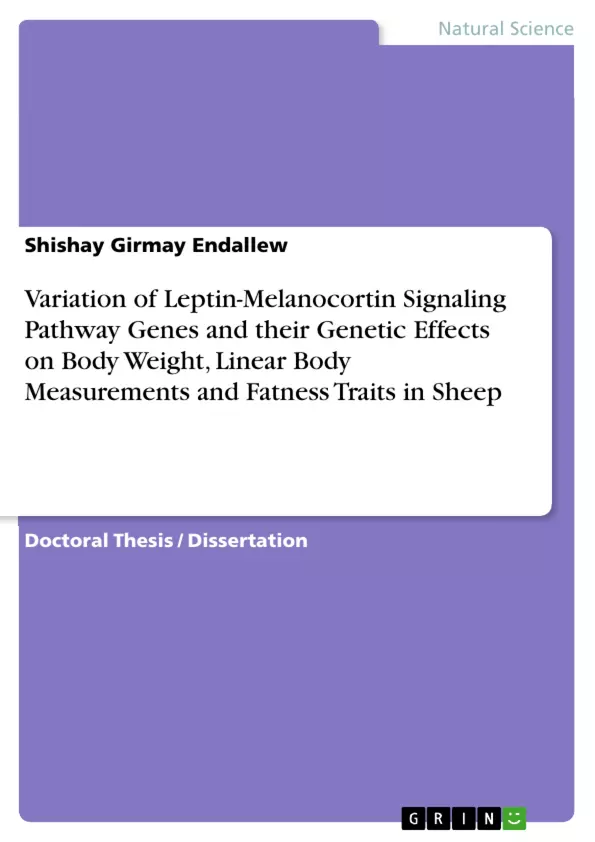This thesis focuses on examining the genetic effects of leptin-melanocortin signaling pathway genes, specifically MC4R, STAT3, and LEP, on body measurement and fatness traits in sheep. The study recognizes that an animal's phenotype performance for a specific trait is influenced by both its genetic merit and the environmental factors it experiences. To improve genetic traits in sheep, it is crucial to define the genetic component associated with the trait of interest.
The research identifies major genes within the leptin-melanocortin signaling pathway that significantly impact growth and lean meat production. The study utilizes various techniques such as bioinformatics tools, Polymerase Chain Reaction (PCR) direct sequencing, General Linear Models (GLM), immunohistochemistry (IHC), and promoter region analysis to investigate the variations, structure, function, and expression of these genes in different tissues of sheep.
While studies have begun to gain insight into chromosomal locations that regulate economically valuable traits in sheep, much unearthing works remained to be done regarding the generation of practical genomics information that can be applied to genetic improvement of reproduction, disease resistance, production, and carcass quality traits in sheep. Although preceding researchers have reported SNPs in the major genes of the leptin-melanocortin signaling pathway, including the MC4R and LEP has reported an association with various economically important traits in sheep. The effect of the STAT3 genotypes on body weight and fatness in sheep is not determined. Moreover, the association of variants in the promoter region of the MC4R gene with the economically important traits and the promoter region of the gene was not delineated. So, this study was crucial to enlighten these research gaps.
Inhaltsverzeichnis (Table of Contents)
- Introduction and Literature Review
- Introduction
- Problem Statement
- Justification
- Candidate gene approach and genetic association
- Genetic markers
- Restriction fragment length polymorphisms (RFLPs)
- Microsatellites
- Single nucleotide polymorphisms
- SNP Discovery Methods
- Use of SNP Markers in Industry
- The sheep growth and development
- Fat deposition and meat value
- The melanocortin system genes
- Central neural circuits energy homeostasis
- A leptin/melanocortin pathway
- MC4R gene polymorphism in livestock
- STAT3 gene polymorphism in livestock
- Overview of Experiments, Hypotheses and Objectives
- General Overview
- Study One: The leptin-melanocortin system modulates rapid growth and muscular high-yield carcass in sheep through adipocytokine signaling pathway.
- Study Two: Genetic Variations in the MC4R gene linked to elevated body weight and fat-related traits in sheep.
- Study Three: STAT3 Gene Expression and Its Role in Sheep Body Weight and Fatness Modulation
Zielsetzung und Themenschwerpunkte (Objectives and Key Themes)
This dissertation explores the genetic effects of variations in leptin-melanocortin signaling pathway genes on body weight, linear body measurements, and fatness traits in sheep. It investigates the role of these genes in modulating growth, carcass composition, and energy homeostasis. The research utilizes a candidate gene approach, focusing on single nucleotide polymorphisms (SNPs) within specific genes of interest.
- Genetic effects of leptin-melanocortin signaling pathway genes on sheep phenotypes
- Role of SNPs in modulating growth, carcass composition, and fat deposition
- Impact of genetic variation on energy homeostasis in sheep
- Potential for marker-assisted selection in sheep breeding
- Insights into the genetic mechanisms underlying sheep production traits
Zusammenfassung der Kapitel (Chapter Summaries)
- Introduction and Literature Review: This chapter provides a comprehensive overview of the leptin-melanocortin signaling pathway, its role in energy homeostasis, and its association with growth and fatness traits in sheep. It discusses candidate gene approaches, genetic markers, and SNP discovery methods, setting the stage for the subsequent research investigations.
- Chapter 2: Study One: This chapter focuses on the leptin-melanocortin system's modulation of rapid growth and muscular high-yield carcass in sheep through adipocytokine signaling pathway. It investigates the relationships between SNPs in the MC4R and STAT3 genes and growth and fatness traits, exploring the potential for marker-assisted selection in breeding programs.
- Chapter 3: Study Two: This chapter investigates genetic variations in the MC4R gene and their link to elevated body weight and fat-related traits in sheep. It analyzes the association between specific MC4R gene polymorphisms and phenotypic traits, offering insights into the gene's role in regulating fat deposition and overall body size.
- Chapter 4: Study Three: This chapter examines the expression and role of the STAT3 gene in modulating sheep body weight and fatness. It explores the relationship between STAT3 gene expression levels and phenotypic traits, shedding light on the gene's involvement in energy balance and fat accumulation.
Schlüsselwörter (Keywords)
This dissertation focuses on the leptin-melanocortin signaling pathway, genetic variation, single nucleotide polymorphisms (SNPs), sheep growth and development, body weight, carcass composition, fatness traits, MC4R gene, STAT3 gene, adipocytokine signaling pathway, marker-assisted selection, and energy homeostasis.
- Citar trabajo
- Shishay Girmay Endallew (Autor), 2019, Variation of Leptin-Melanocortin Signaling Pathway Genes and their Genetic Effects on Body Weight, Linear Body Measurements and Fatness Traits in Sheep, Múnich, GRIN Verlag, https://www.grin.com/document/1369493



